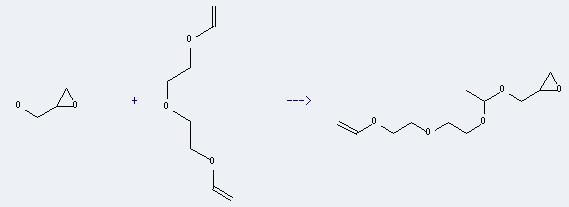-
Name
Diethylene glycol divinyl ether
- EINECS 212-133-3
- CAS No. 764-99-8
- Article Data15
- CAS DataBase
- Density 0.931 g/cm3
- Solubility Insoluble in water.
- Melting Point -21 °C
- Formula C8H14O3
- Boiling Point 195.4 °C at 760 mmHg
- Molecular Weight 158.197
- Flash Point 62.2 °C
- Transport Information
- Appearance
- Safety 26-36
- Risk Codes 36/38
-
Molecular Structure
- Hazard Symbols R36/38:Irritating to eyes and skin.;
- Synonyms Ether,bis[2-(vinyloxy)ethyl] (6CI,7CI,8CI);3,6,9-Trioxaundeca-1,10-diene;Bis[2-(vinyloxy)ethyl] ether;DEGV;Divinylcarbitol;NSC 6117;Rapi-Cure DVE 2;{2-[2-(ethenyloxy)ethoxy]ethoxy}ethene;1-ethenoxy-2-(2-ethenoxyethoxy)ethane;
- PSA 27.69000
- LogP 1.32320
Diethylene glycol divinyl ether Consensus Reports
Reported in EPA TSCA Inventory. Glycol ether compounds are on the Community Right-To-Know List.
Diethylene glycol divinyl ether Specification
The Diethylene glycol divinyl ether, with the CAS registry number 764-99-8 and EINECS registry number 212-133-3, has the IUPAC name of 1-ethenoxy-2-(2-ethenoxyethoxy)ethane. It is a kind of light sensitive chemical, and belongs to the following product categories: Aromatics Compounds; Monomers; Polymer Science; Vinyl Ethers. And the molecular formula of the chemical is C8H14O3. What's more, it is always used for preparing acetaldehyde by Mercury-free method, and it is also used in the synthesis of various polymeric materials.
The physical properties of Diethylene glycol divinyl ether are as followings: (1)ACD/LogP: 0.81; (2)# of Rule of 5 Violations: 0; (3)ACD/LogD (pH 5.5): 0.81; (4)ACD/LogD (pH 7.4): 0.81; (5)ACD/BCF (pH 5.5): 2.43; (6)ACD/BCF (pH 7.4): 2.43; (7)ACD/KOC (pH 5.5): 65.79; (8)ACD/KOC (pH 7.4): 65.79; (9)#H bond acceptors: 3; (10)#H bond donors: 0; (11)#Freely Rotating Bonds: 8; (12)Polar Surface Area: 27.69 Å2; (13)Index of Refraction: 1.429; (14)Molar Refractivity: 43.79 cm3; (15)Molar Volume: 169.8 cm3; (16)Polarizability: 17.36×10-24cm3; (17)Surface Tension: 27 dyne/cm; (18)Density: 0.931 g/cm3; (19)Flash Point: 62.2 °C; (20)Enthalpy of Vaporization: 41.39 kJ/mol; (21)Boiling Point: 195.4 °C at 760 mmHg; (22)Vapour Pressure: 0.59 mmHg at 25°C.
Uses of Diethylene glycol divinyl ether: It can react with oxiranyl-methanol to produce 2-{1-[2-(2-vinyloxy-ethoxy)-ethoxy]-ethoxymethyl}-oxirane. This reaction will need reagent perfluorobutyric acid. The reaction time is 2 hours with temperature of 30-40°C, and the yield is about 85%.

You should be cautious while dealing with this chemical. It irritates to eyes and skin. Therefore, you had better take the following instructions: Wear suitable protective clothing, and in case of contacting with eyes, rinse immediately with plenty of water and seek medical advice.
You can still convert the following datas into molecular structure:
(1)SMILES: O(\C=C)CCOCCO\C=C
(2)InChI: InChI=1/C8H14O3/c1-3-9-5-7-11-8-6-10-4-2/h3-4H,1-2,5-8H2
(3)InChIKey: SAMJGBVVQUEMGC-UHFFFAOYAT
The toxicity data is as follows:
| Organism | Test Type | Route | Reported Dose (Normalized Dose) | Effect | Source |
|---|---|---|---|---|---|
| mouse | LD50 | oral | 2570mg/kg (2570mg/kg) | Gigiena i Sanitariya. For English translation, see HYSAAV. Vol. 42(3), Pg. 12, 1977. | |
| rabbit | LD50 | skin | 14100uL/kg (14.1mL/kg) | American Industrial Hygiene Association Journal. Vol. 23, Pg. 95, 1962. | |
| rat | LD50 | oral | 3730mg/kg (3730mg/kg) | American Industrial Hygiene Association Journal. Vol. 23, Pg. 95, 1962. |
Related Products
- Diethylene glycol
- Diethylene glycol bis(3-aminopropyl) ether
- Diethylene glycol bis-glycidyl ether
- Diethylene glycol di(p-toluenesulfonate)
- Diethylene glycol diacrylate
- Diethylene glycol dibenzoate
- Diethylene glycol dibutyl ether
- Diethylene glycol dimethacrylate
- Diethylene glycol dimethanesulfonate
- Diethylene glycol dinitrate
- 76500-03-3
- 765-01-5
- 765-03-7
- 765-04-8
- 76-50-6
- 765-07-1
- 76508-73-1
- 7650-89-7
- 7650-91-1
- 765-09-3
Hot Products
About|Contact|Cas|Product Name|Molecular|Country|Encyclopedia
Message|New Cas|MSDS|Service|Advertisement|CAS DataBase|Article Data|Manufacturers | Chemical Catalog
©2008 LookChem.com,License: ICP
NO.:Zhejiang16009103
complaints:service@lookchem.com Desktop View